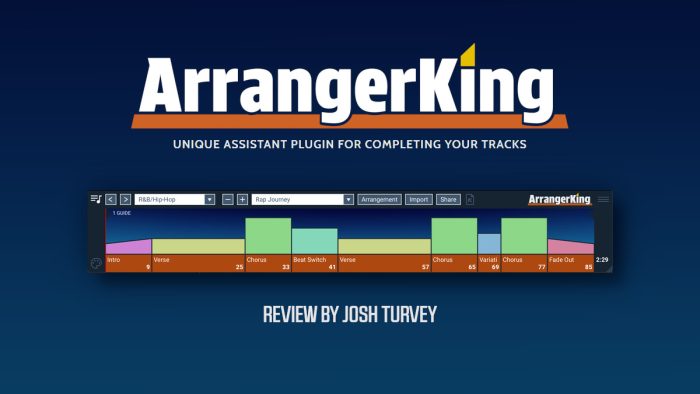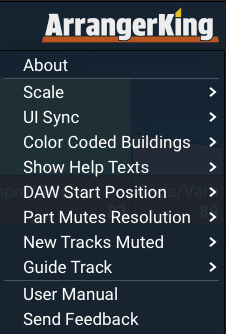A few weeks ago I teamed up with the creator of ArrangerKing to promote this unique plugin. The initial reception has been overwhelmingly positive, and I believe it can be a real game-changer for many producers.
Check out what NoiseQuest’s Josh Turvey makes of ArrangerKing, and make sure to read to the end to find an exclusive offer!
Summary
ArrangerKing is a one-of-a-kind plugin that achieves the rare feat of being completely unique and innovative, whilst also providing a simple and elegant solution to a common problem.
There are many tools that profess to aid in the songwriting process; ArrangerKing delivers on this by mapping out a cohesive and fluid song structure, enabling users to focus their attention on the creative refinements and enhancements that will truly elevate their arrangements.
Pros:
- An innovative solution that solves an essential music production task, rapidly speeding up the structural aspect to the arrangement process.
- Quick, simple and effective to use.
- Thoughtful features for deeper control and excellent implementation.
- Takes the pain out of an extremely necessary and sometimes mundane task.
- Excellent forum and public roadmap.
- A growing library of freely available song templates to inspire new song structures and arrangements.
Cons:
- The ‘Quick Chords’ & ‘MIDI’ features are currently limited and yet to mature. They are decent for creating a rough outline but more features are needed (e.g. Chord Qualities, Scales and Inversions etc.) to elevate this aspect of the plugin.
- This might not be possible to implement, but changes made to the arrangement within the plugin (e.g. muting the Bass in a specific section) aren’t visually reflected in the DAW. The audio in the section will be muted, as expected, but ArrangerKing is currently unable to make the physical edits outside of the plugin. This is not a dealbreaker by any measure, but developments in this area would enhance an already amazing user experience.
Intro
‘8-Bar Syndrome’. ‘The 8-Bar Loop of Death’. The Cycle of Pain’… No matter the moniker attributed to it, virtually every music producer familiar with working in a Digital Audio Workstation (DAW) has suffered from this affliction in some form or another. We all know the feeling: the drums are popping; the bass is grooving; the chords are gelling; the melody is soaring; but after the 8-Bar cycle ends, everything resets, and the thought of arranging your idea into a fluid composition worthy of its potential is both daunting and paralysing.
Outside of the tools and utilities already provided within your DAW of choice, there have been remarkably few attempts to address the issue outlined above. Given the near-infinite array of plugins we have at out disposal, this seems like a surprising omission – one that’s been made all the more glaring by the recent launch of Barking Audio’s innovative ‘ArrangerKing’.
Although still in its early stages, the plugin is primed to occupy this void in the market. By providing an elegant solution to creating and implementing song structure, and combining it with some basic MIDI-generation features, ArrangerKing rapidly speeds up the song-creation process and solves an issue common to many of the major, popular genres.
Design & Features
ArrangerKing houses its functionality in a deceptively simple design. Upon opening the plugin, users will most likely be drawn to the central panel (see image above). This displays the currently selected song structure in a series of colourful blocks, all shaped and sized according to the different song sections, whose names and bar counts reside in the bottom row.
Conveniently, the total time duration displayed on the right of the panel is calculated by matching ArrangerKing’s song structure to the DAW’s project tempo, thereby giving the user a complete overview of the song’s layout.
In addition to providing visual feedback, this panel is highly interactive. Clicking on the blocks will mute/unmute the various song sections, and users can choose when an element should start and stop playing in a section by dragging on the block borders (click GIF above).
Importantly, users can completely customise the song structure by right-clicking on the blocks and using the context menu to change, duplicate, rearrange, and remove the respective sections. It’s also possible to change the length of each section by clicking on their titles in the bottom row and selecting a different bar count.
Alternatively, users can select a song structure from the included presets using the main toolbar (see image above), which also provides access to the preset importing, exporting, and saving functions. Once the user is happy with their settings, the song structure can be dragged (see red square in the image above) onto a MIDI track for use as a visual guide, which, depending on your DAW, will create a MIDI clip that looks something like the image below.
Users will note that this MIDI clip matches the design of the song structure in the ArrangerKing plugin. Its sole purpose is to act as a guide so that users can arrange their audio and MIDI clips accordingly, and it should be noted that it’s not intended to output any audio.
Whilst this is an undoubtedly useful workflow, ArrangerKing has much more in its locker, which is explored below.
Turning our attention to the settings, which can be found by clicking on the ArrangerKing logo (click to see image), users can access multiple functions to customise their workflow.
Of particular note is the ‘New Tracks Muted’ setting. When enabled, ArrangerKing will automatically mute each section when it is inserted onto a track, as indicated by the greyed out blocks (see image below). Users can then choose the sections they want to enable for that track by clicking on the relevant blocks.
Lastly, ArrangerKing provides some basic MIDI functionality, which is accessed by clicking the notation icon in the top-left of the main toolbar. Users can build basic chord progressions for each section (see image below) and drag the MIDI onto the relevant MIDI tracks in their DAW.
Alternatively, ArrangerKing can send that MIDI directly to another track. Please note that the latter option will only work if the track receiving the MIDI also has ArrangerKing inserted onto it. It should also be noted that the MIDI features are currently extremely basic. As such, they are best used to create a quick guide, with users likely needing to heavily edit the MIDI to make it work with their composition.
In Use
The features described above outline a comprehensive feature set, with ArrangerKing demonstrating remarkable versatility in its application. The plugin thus encourages users to develop their own workflows once they get acquainted with it.
To help newcomers get started, Barking Audio have an excellent video tutorial on their website, which outlines an approach consisting of two main steps: creating a visual guide track, and using ArrangerKing’s internal muting capabilities to automatically assign individual instruments to different song sections. Having adopted this workflow myself, I think this is an excellent implementation, but out of respect to the original creator of the video, I’ll not re-describe the workflow here.
Whilst the internal muting capabilities add an incredible depth to ArrangerKing’s utility, I frequently find myself turning to the plugin for the much simpler task of sketching out potential structures and experimenting with different guide tracks. Admittedly, this doesn’t maximise ArrangerKing’s potential, but using the plugin to create a database of song structures inspired by my favourite artists has already provided untold amounts of inspiration.
An effective arrangement will most likely contain two essential features: a clearly defined song structure with repeatable sections; and non-cyclical elements that break up the monotony of repetition, with the purpose of adding interest and dynamism to the composition. ArrangerKing excels at the former, thereby freeing up the user to focus on the more creative aspects of the arrangement, such as: transitions, automation, effects, and other detailed minutiae that enhances the overall composition.
Conclusion
Ultimately, almost any implementation of ArrangerKing will likely speed up the time it takes to produce music more efficiently and effectively. Having taken the time to familiarise myself with the plugin and implement it into my workflow, I can confidently assert that it’s become a mainstay in my default project template, which is about the highest possible honour any producer can bestow upon a plugin.
Whether using it to build a database of song structures from your favourite artists, or as a guide track to automatically control the song structure within your DAW, I’m confident that many users will be able to extract incredible value from ArrangerKing. With this release, Barking Audio have proven that there’s still room for incredible innovation in plugin development, and I’m excited to see how ArrangerKing grows and evolves with future iterations.
Technical Info
- Simple download, installation and authentication process. User account isn’t required to register the plugin, which is unlocked by the licence code emailed to the user after purchase.
- Mac & PC are both supported, with options for VST3 and AU.
- Excellent manual that covers the major DAWs so that you can get the maximum use out of ArrangerKing.
- CPU Usage is light.
Alternatives
- N/A
In celebration of Josh’s glowing review of ArrangerKing, you can get the plugin at an exclusive 60% discount for a limited time! Regularly priced $54 USD (+ VAT in EU and UK), you can buy ArrangerKing at half off with coupon code REKKERDAK60 at the checkout.
IF you would first like to try it for yourself, you can download a fully-functional copy of ArrangerKing at the BarkingAudio website.





 click to see image
click to see image


